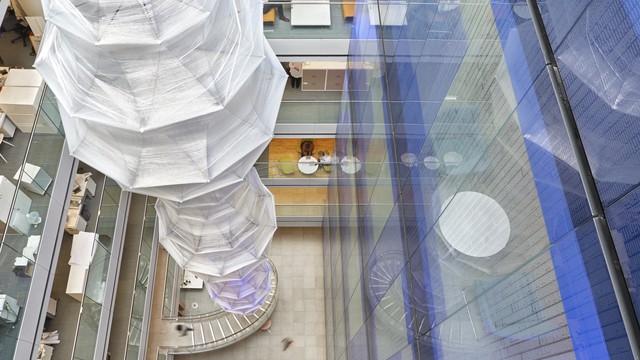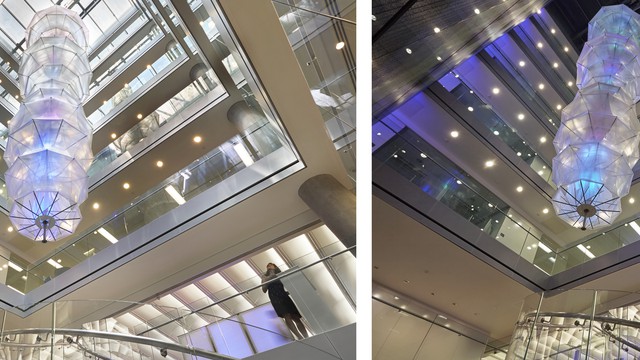The Sentiment Cocoon 2015, United Kingdom, London
The Sentiment Cocoon




The Sentiment Cocoon is a temporary interactive installation that seeks to capture and express human sentiment through the medium of light. Simple interfaces allow participants to express in the public domain how they feel by how they touch. These interactions are then transformed into pulses of light that travel throughout the cocoon. The focus is on the exploration of architectural form through digital fabrication, with translucent materials and responsive lighting to facilitate social interactions. Ultimately, the installation turns its surroundings into a stage for social encounter through interaction and observation.
The Sentiment Cocoon is a site specific interactive installation designed by architect Moritz Behrens and lighting designer Konstantinos Mavromichalis for Arup’s headquarters in London. The artwork seeks to capture and express human sentiment through the medium of light. These interactions are then transformed into pulses of light that travel throughout the cocoon. The cocoon generates a striking visual display of light that has been informed by people’s feelings. The intent was to design a continuous and organic cocoon-like lightweight structure that would wind itself up the atrium and connect all seven floors. The focus is on the exploration of architectural form through digital fabrication, with translucent materials and responsive lighting to facilitate social interaction. The visualisations are designed to encourage individual interactions and collective observations. When a user swipes her smart card and thus submits her sentiment, a white flash of light instantly illuminates the cocoon. This white flash of light is intended to mirror the participant’s presence and to make her feel like they have actually transformed their presence and sentiment into a pulse of light. The purpose of the visceral lighting response is to playfully reward participation with a moment of instant gratification, which in turn encourages further interactions with the artwork or with bystanders. The system architecture of the artwork allows for the tracking and displaying of several behaviours. Individual swipe cards such as the London Oyster card enable participants to express how they feel based upon three categories related to workplace wellbeing. These parameters are encoded into lighting patterns that suggest the collective mood of participants. The sentiments are encoded in different colours and movement. Colour gradients, velocity and movement are represented through patterns. Over time, the patterns become recognisable as the overriding sentiment of the day.
Details
Building or project owner : Arup Ltd
Architecture : Moritz Behrens
Project artist/ concept/ design/ planning : Moritz Behrens / Konstantinos Mavromichalis
Structural engineering : Christian Dercks (Arup)
Light design : Konstantinos Mavromichalis / Moritz Behrens
Lighting control software : Nathan Whitford
Project co-ordination : Greg Chandler (Arup Ltd)
Descriptions
Kind of light creation : The lighting design of the cocoon creates an enigmatic display. Natural daylight, from the atrium skylights above, blend with the light emitted from the cocoon’s spine. This allows for rich interactions of varying forms of light and, through the translucency of the material, results in a striking visual display that has been informed by the feelings of the building’s occupants.
Resolution and transmitting behaviour : The Pixel RGB LED system is comprised of four 400 node, 30 degree outward projecting continuous LED strands anchored to the core of the cocoon. Supplied by a 12 VDC power pack and Artnet control unit, the projected light passes through a special lenticular diffusion membrane before landing the partially translucent skin of the Cocoon itself.
Pixel distance : 4800 pixels 8mm (approx) on centre spacing with a visualisation resolution of 400 pixels or 20 pixels per RGB node.
Luminace : The central light core outputs a total of 5600 lumens/m. The sentiments are encoded in different colour gradients, the velocity of the colour and movement are represented by animated patterns. Over time, the patterns will become recognisable and, as a result, people working in the building will experience the overriding sentiment of the day within the office.
Urban situation : The Sentiment Cocoon was commissioned by Arup for their No8 Fitzroy building in London UK. Primarily the Sentiment Cocoon was created for Arup staff to interact with and observe with. Portion of the work was visible to the public from the entrance foyer. The location of the atrium is a very deliberate context for the piece as it is socially and spatially a central to most all architectural spaces.
Description of showreel : Video: https://goo.gl/6W8gdB Flickr: https://flic.kr/s/aHskbh5c8Y This video has been produced by Arup to showcase the project. In this reel key people on the project discuss their involvement and aspects of the Cocoon itself that are noteworthy.